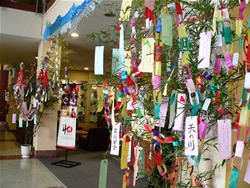The Tanabata or Star Festival is an unofficial celebration in Japan; However, it is a very widespread tradition, which is celebrated on July 7 of each year.
Legend has it that long ago there were two young people named Orihime and Hikoboshi. Orihime was very skilled at weaving on the loom, and lived on the west side of the Milky Way (Amanogawa). Hikoboshi lived on the east side and took good care of the livestock.
They were both very hardworking, so God (Kamisama) made them meet and get to know each other. But once they started living together, they neglected their work and from morning until night they only dedicated themselves to talking by the river. The loom became dusty and the cows began to die, so Kamisama became upset and separated them, allowing them to meet only once a year, on the night of July 7.
Turned into stars, Orihime (the Vega star) and Hikoboshi (the Altair star) can then shine together on both sides of the Milky Way on this date, when the Japanese write their wishes on thin papers (tanzaku) that hang in the branches of bamboo trees, hoping that these stars will fulfill them.
In our country
This festival is also experienced in the Peruvian Nikkei community, always creating a lot of expectation. Both in schools and in the Peruvian Japanese Cultural Center, bamboo bushes are placed where children and older people draw and write their wishes.
People who visit the Peruvian Japanese Cultural Center thus come closer to this living expression of Japanese culture, learning about the symbolism it contains and becoming infected with the color and magic of this festivity. Who doesn't have dreams that they would like to be fulfilled?
* This article was originally published on July 5, 2007 on the website of the Peruvian Japanese Association (APJ), Affiliated with Discover Nikkei.
© 2007 Asociación Peruano Japonesa and Harumi Nako















